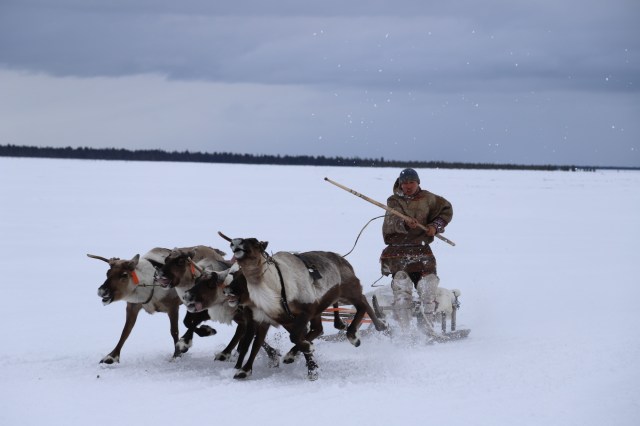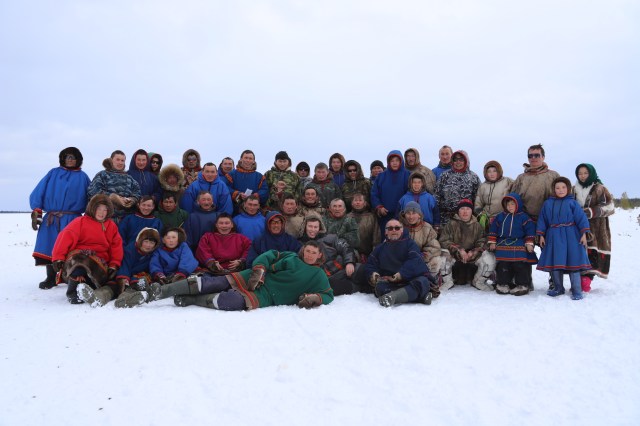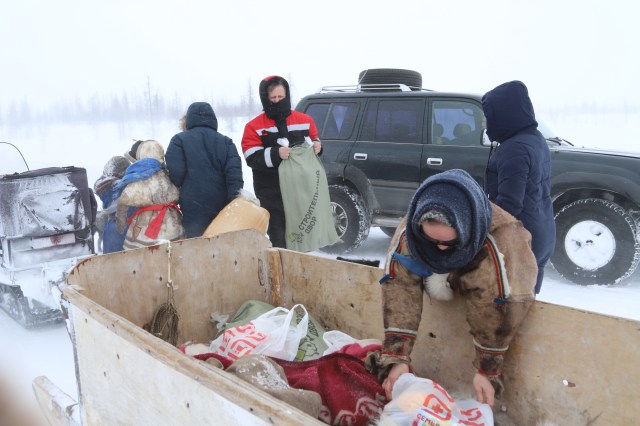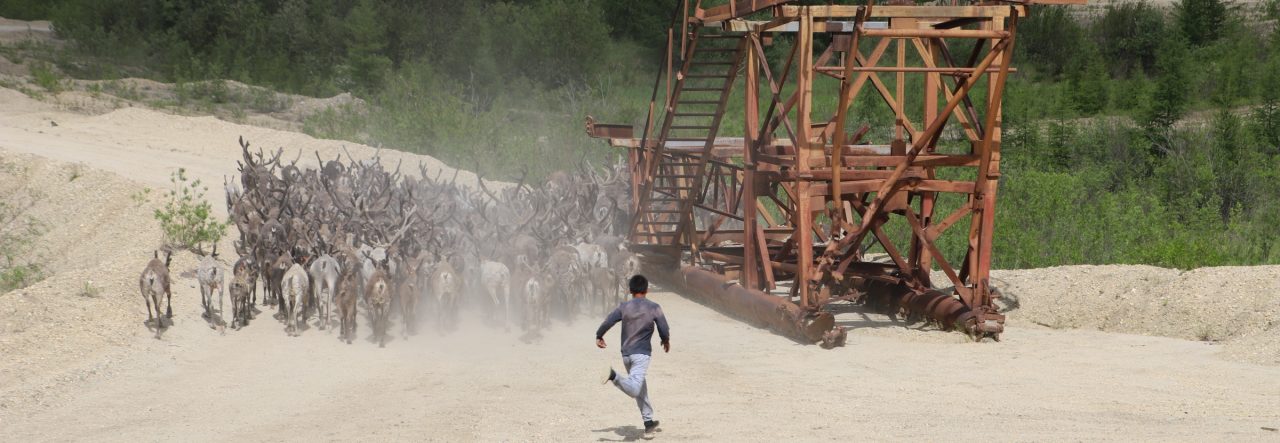I have been doing fieldwork with Yamal Nenets reindeer herders for more than 20 years now, and have noticed this year a change in their perception of the changes happening around them, maybe partially reinforced by corona virus.
Be it industrial expansion, the icing-over of pastures, outbreaks of diseases, methane holes in the tundra, the change of a political regime or other disasters – they have always given me the impression of incredible self-confidence that whatever comes, these tough enthusiastic nomadic reindeer herders will manage to face the challenge and continue their life. I witness some of this still in the tundra: this year for example the annual reindeer herders day festival – the main party of the year for herders – was cancelled due to Corona obviously. Usually, these are big gatherings of hundreds of herders, featuring a meeting where spring migration schedules and routes are discussed, and then – most importantly – reindeer races take place.

In absence of the big festival and meeting, herders self-organised in smaller groups instead and held meetings and races among neighbours.

One such meeting was in the 20th brigade of the Yar-Sale herding enterprise, not too far from the city oc Nadym, end of March 2020. Instead of big prices awarded by oil and gas companies and municipalities, every reindeer herder participating in the races offered one 2 year old male reindeer as a contribution to the award. With 12 participating racers, this meant that the first winner got 6 reindeer as an award, the second four, and the third two. During the races one could really feel the mood of “so what – if the officials don’t want us to have our meetings in town because of Corona, we have it in the tundra”. And my host for these weeks mentioned that “we have our own way of running things here”. It made sense to me that the Russian laws are good for villages run by Russians, but not necessarily for organising herders actions in the tundra. Good legal anthropology, yes?
But the change in the perception was that it seems now in times of corona, people try to get news over their mobile phones and satellite TV even when they are in their nomadic camps, and there is more and more talk about conspiracy theories for all these disasters.
Not only the Corona, but also the anthrax, the iced pastures, the craters on yamal and all other significant changes. This made me think that people have such a strong sense of “we can manage all challenges” that the only way of interpreting things that they CAN NOT cope with is when it is a conspiracy. That’s why I heard from several that the corona pandemic may be the works of some group of secret world rulers who decided to paralyse the globe for their own benefit. In the same way as some thought the big pasture icing event was aggravated by people who wanted consciously to reduce the number of reindeer and people on the Peninsula, and the anthrax outbreak was the work of evil forces that wanted to empty the area for making space for industry infrastructure.
This is an interesting pattern: could it be that nowadays conspiracy has partially taken over from the spirits as an explanation how things occur that are beyond the herders capacity to adapt?
So is there any immediate influence of corona on nomadic life in the tundra? Yes in so far as herders try to minimise their going to town for their big spring shopping. I have seen them ordering supplies to be delivered to the road side by car, from where they would pick up their supply and pay for them on the spot through mobile banking, as close to the road there is a phone signal.

There seems to be general agreement that not going to town any more is a good way from preventing the virus to spread to the tundra. This brings, however, a conflict of interest to light: migration should be ideally good for the reindeer, and not for the people. The elders agree that now for the reindeer it is better to not move too fast towards the Yamal Peninsula. However, my host’s son Andrei thinks that where they are now, close to Nadym, even though there are lichen-rich pastures, it’s dangerous to be in the vicinity of a big town with corona. So they decide to move northwards earlier.
Before doing so, we get a lot of petrol for them to carry with them on their migration. The reason: this year the winter road to the main village Yar Sale on the Yamal Peninsula was so unstable that no fuel-trucks delivered anything to the village.

So the price of petrol there is twice higher than in the gas town of Nadym. Some herders are reported to even have traded fuel from Nadym to people in Yar Sale as a business. The warm winter has made the winter road undriveable – a toll to climate change?


Your comparison between conspiracy theories and the belief in spirits is convincing. I just see one major difference. The relationship of humans with spirits is based on negotiation and reciprocity. In the case of conspiracy theories, neither reciprocity nor negotiations are possible. Conspiracy theories grew out of the feeling of mistrust and uncertainty. The belief in spirits grew out of the experience of radically limited agency as well but is linked with abilities to communicate through ritual and religious specialists like shamans. Conspiracy theories call for radical measures, like genocides or revolutions, shamanic rituals call for balancing the perspectives and interests of different inhabitants of the same environment. Even the evilest men-eaters among the spirits have a right to existence in the eyes of the Nenets. I don’t see this legitimacy for secret plots and conspiracies. When religion becomes reduced to “superstition” – to an unsystematic perception of danger and fear and random rules of taboo – it becomes something similar to belief in conspiracies. I don’t see Nenets beliefs in that light. Maybe you can find it in the perception of evil and devil among the converts to protestant churches?
Dear Stephan
thank you for your in-depth thinking on this blog entry. This was very “fresh” written right after coming out of the forest. I really do agree with you: the relation with spirits is reciprocal, while the one with some unknown powers is not. Thinking this comparison further, it comes to mind that among the Nentsy, much unlike in Yakutia, there is this perception that part of this reciprocity with the spirits is now being lost, because of the disappearance of the shamans. The Tadibe used to be the one who made the relation between people and the spirits reciprocal, and only the Tadibe could negotiate. It was through the Tadibe that people approached the spirits and entered in dialogues. Most tundroviki would tell us to day that this is a serious change in spirituality that this does not happen any more. There is still interaction with the spirits, but with the first generation of people who did not see shamans practicing any more, it’s more a repeating of rituals that they have seen the elders perform, rather than real dialogue I guess. Sacred items are not being renewed any more, drums not repaired, idoly rarely any more “re-charged” on sacred sites, sacred sites are not being restored anymore when they get destroyed, etc. People have a really hard time re-organising the reproduction of the spiritual material culture and practice in absence of the shamans as crucial link. Maybe this explains my impression in the lesotundra this time that there was a sense of anxiety and powerlessness that made me feel the limits in the Nenets perception of their own resilience. We should invite Roza and Lena Lyarskaya to comment on this thread too:)
I think that this idea of a conspiracy does not have anything about Nenets religion, but it is the product of Soviet education, which was described also in William Edwin Segall’s book School Reform in a Global Society and Malchish-Kibalchish hero there (2006). Talking about the present situation of Coronavirus pandemics, I think that aminals and nature have more benefits now, as Florian wrote here “This brings, however, a conflict of interest to light: migration should be ideally good for the reindeer, and not for the people”. It means that nature can quickly recover from the results of human activities, but for humans, it will take a very long time to recover from it. This pandemic shows also, that we, humans, are not gods, we did not manage to domesticate the whole Earth, but we remain its slaves…
Thank you Florian for this really densely packed set of field observations. Wow! It raises so many important issues. And thanks to Stephan and Roza for the thoughtful responses. My long-term experience on the Yamal tundra is similar in that for most of the time I have been doing fieldwork there, I have rarely seen people questioning their own resilience in the face of various challenges. I can think of four ‘events’ where I sensed some deep level of concern. The first was when the road/railway corridor between Obskaya and Paijuta was built very quickly ca. 1988-1991, after which further construction was abruptly halted due to the recession caused by the Soviet Union’s collapse. I breifly visited Kharasavei and Bovanenkovo during summer 1991 and worked near Bovanenkovo and, especially, Laborovaya for several months during summers 1993 and 1995. Nentsy migrating with reindeer and fishing in the rivers and lakes along that Obskaya-Paijuta corridor raised quite a number of serious issues and said clearly that the negative impacts and long-term implications were worrying to them. The second time was with you, Florian, during fieldwork near Bovanenkovo in summer 2004, when Gazprom reps came to the tundra to announce the region north of Se-ykha River would soon be closed to migration due to the nature and density of planned infrastructure. The third time was at Day of Reindeer in Yar-Sale in early April 2014, when the impacts of the catastrophic winter 2013-14 icing event were still unfolding, i.e. reindeer were still dying and people were being stranded in the tundra with no draught animals. Being in Yar-Sale with Roza and Nina Meschtyb, herders expressed deep concern about the magnitude of that particular icing event and worried that if another one happened too soon, they would not have time to rebuild their herds. Thus, they asked us quite directly if we knew what was causing the events and whether it was possible to foresee them at all. These issues and questions helped lead eventually to the EU-funded CHARTER project and the NSF-funded AROSS project (which involves Roza and Shari Fox). More on that in the minute. The last time was in summer 2017 during the heat wave (32°C for about 2 weeks at 70°N, near Mordy-yakha, about 20 km southeast from Bovanenkovo). 2016 had been the warmest summer on record on Yamal, during which fires raged down south in the lesotundra, methane was bubbling up on Yamal Peninsula and Ostrov Belyi, and the anthrax outbreak occurred. During fieldwork with Roza and Nina, herders noted that the winter air temperature had gotten so cold around New Years that many relatively shallow yet important fishing lakes had frozen to the bottom, killing the fish. In ‘normal’ times, herders observed that such lakes would be repopulated within a few years as fish moved in via small creeks, or even via extremely wet/saturated mires. However, during that second consecutive heat wave in July-August 2017, they observed that the small creeks and mires were too dry for any fish to be able move back into the lakes. This ‘cascading’ effect of the combination of extreme heat in back-to-back summers combined with extreme cold in the intervening winter was setting up a situation beyond their control. This was at a time when people were still not slaughtering reindeer in that area because of the need to continue rebuilding their herds so they could migrate. Some of the same families who we spoke with there in 2011 and 2014, said (and I am paraphrasing loosely from memory) something along the lines of “you guys come and fish for a couple of weeks, and have lots of other food brought in you by helicopter. So, you are fiine. We are here year-round trying to reebuild our herds and for us the fishing has become a matter of life and death. We take it very seriously.” I am not qualified to speculate on the “conspiracy” hypothesis, but to me the collective comments by Roza, Florian and Stephan above nicely summarizee the different driving forces. Getting back to future research on icing events and long-term reindeer rangeland dynamics under the auspices of projects like CHARTER and AROSS, it seems we will need to understand more clearly than ever before the very real sensitivities surrounding these issues. I am thankful to have such a well-informed group for sounding out these issues in real time with such esteemed colleagues! With or without corona, we are living through a time of rapid change in Nenets tundra regions.
Thank you Bruce for your detailed thoughts. I agree about the magnitude of the 2013/14 icing event. On the other hand, now seven years after, it becomes clear that – as you write further down in your reply – it is the ‘cascading effect’ that makes it so hard for people to rebuilt their herds, the repetition and increased frequency of events. And that is additionally complicated by rules that turn illegal the traditional ways of restoring your herds such as fishing . At least in the Ob Bay people are not any more allowed to fish, and that’s where the most productive fishing grounds are. While on the other hand industry is allowed to use the Ob and Taz Bay… So some end up having to move to villages and become sedentary, where they don’t have much to do. An all too sadly known story from everywhere else when nomads had to settle.